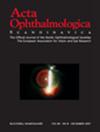Performance of a simplified strategy for formula constant optimisation in intraocular lens power calculation
Abstract
Purpose
To investigate the performance of a simple prediction scheme for the formula constants optimised for a mean refractive prediction error.
Methods
Analysis based on a dataset of 888 eyes before and after cataract surgery with IOL implantation (Hoya Vivinex). IOLMaster 700 biometric data, power of the implanted lens and postoperative spherical equivalent refraction were used to calculate the optimised constants (.)opt for SRKT, HofferQ, Holladay and Haigis formula with an iterative nonlinear optimisation. For detuning start values by ±1.5 from (.)opt, the predicted formula constants (.)pred were calculated and compared with (.)opt. Formula performance metrics mean (MPE), median (MEDPE), mean absolute (MAPE), median absolute (MEDAPE), root mean squared (RMSPE) and standard deviation (SDPE) of the formula prediction error were analysed for (.)opt and (.)pred.
Results
(.)pred – (.)opt showed a 2nd order parabolic behaviour with maximal deviations up to 0.09 at the tails of detuning and a minimal deviation up to −0.01 for all formulae. The performance curves of different metrics of PE as functions of detuning variations show that the formula constants for zeroing MPE and MEDPE yield almost identical formula constants, optimisation for MAPE, MEDAPE and RMSPE yielded formula constants very close to (.)opt, and optimisation for SDPE could result in formula constants up to 0.5 off (.)opt which is unacceptable for clinical use.
Conclusion
This simple prediction scheme for formula constant optimisation for zero mean refraction error performs excellently in our monocentric dataset, even for larger deviations of the start value from (.)opt. Further studies with multicentric data and larger sample sizes are required to investigate the performance in a clinical setting further.


 求助内容:
求助内容: 应助结果提醒方式:
应助结果提醒方式:


